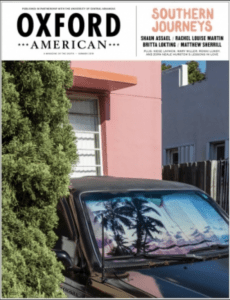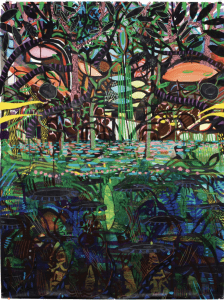My narration for this presentation can be heard by playing the Powerpoint as a slide show.
Author Archives: kemptonjq
Okra (Julia Kempton)
Although its exact origins are unclear, it is likely that okra is native to Africa and South Asia, with its cultivation beginning in the 12th century BC. Through the slave trade, okra came to the United States in the 1500s, where the heat- and drought-tolerant plant thrived in the region’s climate. Okra was one of a few crops that enslaved people were allowed to take to America, so it became a tool for them to keep traditional cooking and agricultural techniques alive through generations. The crop has been grown all over the Southern United States since around 1800 and it is now a common staple of Southern cuisine.
Okra’s many varieties include Cajun Delight, Silver Queen, and Emerald. However, the most popular type of okra is Clemson Spineless, which is praised for being easy to harvest and producing flavorful seed pods. Okra plants can grow up to 6 feet tall, with broad leaves and fruit that can be around 7 inches long in some cases. In the late summer, okra’s harvest season peaks and it continues until the first frost, which kills the plant.
The seed pod and seeds of okra are slimy, giving it a texture that most people either love or hate. In terms of cuisine, it can be tossed into a gumbo, eaten raw, cooked with tomatoes, or combined with a multitude of other dishes. I definitely prefer okra to be sliced, battered, and fried in oil. Growing up on a small farm with many okra plants in our garden, I have fond memories of my dad preparing okra this way and serving it with fried chicken, mashed potatoes, or some type of greens. During the summer, we would have okra many nights in a row, so I started to become tired of it, but I still enjoy a good dish of fried okra any chance I can get it.
Oxford American (Julia Kempton and Colin Burke)
Oxford American is a quarterly literary magazine that is published by The Oxford Literary Project, Inc. along with the University of Central Arkansas (UCA) and it is based in Little Rock, Arkansas. The magazine describes itself as being “dedicated to featuring the best in Southern writing while documenting the complexity and vitality of the American South.” Part of what makes Oxford American different from other popular publications is that they recognize how diverse many communities are in the south. Along with that, they try to focus on all of these different areas, communities, and stories to make sure that the entirety of southern culture can be seen and encompassed by their publications.
Eliza Borné was named the editor in 2015 after the previous editor, Roger D. Hodge, left the magazine earlier in the year. A wide variety of writers contribute to Oxford American. The magazine’s website calls for “personal essays, narrative journalism, and short dispatches and meditations” that address the topic of the issue. Fiction and nonfiction submissions are welcomed, and the list of contributors includes Z.Z. Packer, John Jeremiah Sullivan, Jesmyn Ward, Wendell Berry, John Updike, Leslie Jamison, and many emerging authors.
Oxford American’s content is definitely aimed for the general public and people who are interested in the Southern United States. These are mostly articles talking about various topics that can relate to the south in a variety of ways. This includes music, food, or even southern literature. So, this magazine is definitely more popular due to a lack of scholarly peer reviewed papers. Even though Oxford American appeals to the general public, its audience is mostly middle and upper class. According to the magazine’s demographics sheet, 99% of readers have a college education and the median household income is above $75k. In addition, most readers are in a professional/managerial occupation.
The first publication of Oxford American began in late 1989 in Oxford, Mississippi with Marc Smirnoff as the editor. He decided that there was a need in the South for a magazine similar to the New Yorker, which would focus on the writers and culture of the region. Smirnoff wrote to many famous writers, including John Updike, Richard Ford, and William Steig and asked them to send in contributions for the magazine he had titled Oxford American as a play on H.L. Mencken’s magazine The American Mercury. Several responded and contributed to the magazine. However, in the middle of 1994 the first publication stopped production after a lack of funding. In 1995, John Grisham, a famous novelist who is a native of Oxford, secured enough money to begin the second publication of Oxford American. Again, the magazine ended publication in 2001 as it did not work well as a business venture. The third publication began in 2002 with its headquarters in Little Rock, Arkansas, but low advertising revenue forced it to stop production for a third time only a year later. These first three versions were published entirely in print. The final version of the magazine began publishing in December 2004 as a quarterly after the University of Central Arkansas collected enough funding. Although Oxford American went through an embezzlement scandal in 2008 and owed $700,000 to the university in 2012, the fourth iteration of the magazine is still in widespread circulation and the publication recently released its 100th issue. The currently running publication is mostly in print and mailed out quarterly. However, it is also published online with the magazines available to purchase and select articles available for free as well. As of 2019 there are around 9,000 subscriptions to the magazine as well as it being available in thousands of retail locations.
A recent example of an article from the magazine would be one titled Hunger for the Water from the Summer 2020 issue. Here they talk about the Lowcountry of Louisiana and the role that the water plays there. The article goes into detail about one woman who had lived there her entire life who shows the significance of the water. She owns a restaurant and has published a cookbook and the article ends with a recipe from that book. It is available for free on the website if you are interested in reading it for yourself.
With the magazine focusing on the south it uses lots of southern art and most of the covers for recent magazines have depicted such art, prominent figures from the south, or images that encompass the south in some way. Such examples can be seen below.


Dr. Annette Watson (Political Science)
Dr. Annette Watson is a geographer who works as an Associate Professor in the Political Science department at CofC with a specialty in Human Environmental Geography. She teaches courses on environmental geography, Indigenous/Native American studies, and political ecology. Her research has focused on subsistence economies of North America, natural resource management, and the effect of climate change on indigenous wildlife policy. Dr. Watson got a B.A. in Human Ecology from College of the Atlantic, an M.A. in Northern Studies from University of Alaska-Fairbanks, and a Ph.D. in Geography from University of Minnesota.
At the College of Charleston, Dr. Watson teaches Reading the Lowcountry Landscape (GEOG 219), where students learn about the coastal area of the South where CofC is located. In this class, students use a variety of geographical techniques to analyze places in the Lowcountry. Dr. Watson has also contributed to the field of Southern Studies by collaborating with several Gullah/Geechee communities to “understand their connection to the ecology of the Sea Islands” and the effect of gentrification on their economies. She even participates in the Gullah/Geechee Sustainability Think Tank, which consists of community representatives and academics who research local Gullah communities. Through her collaborations, she has focused on the subsistence economies of these communities. In terms of her personal connection with the South, she says that she has “lived in Charleston since 2008, when [she] first was hired to teach at the College.” Along the way, she has developed many personal and professional relationships with the people who live in the region.
Dr. Watson told me that historical artifacts like “the shell midden rings left by Indigenous cultures from thousands of years ago” and “the sites of some of the earliest European settlement in the colonial era” are a major part of what makes the South such a unique place.” She noted that the varied histories that exist in the South provoke different responses across the cultures of the South and beyond. This is part of what she calls the continuous negotiation of Southern culture. The rich and diverse history of the region is what “produces the uniqueness of the South (and its sub-regions)”, according to Dr. Watson.
Currently, Dr. Watson is continuing her research on Gullah/Geechee communities in the Lowcountry. She also recently conducted research on wildlife management and salmon fisheries conflict. Finally, Dr. Watson expressed her hope that some students in this class take her Reading the Lowcountry Landscape class at some point!

